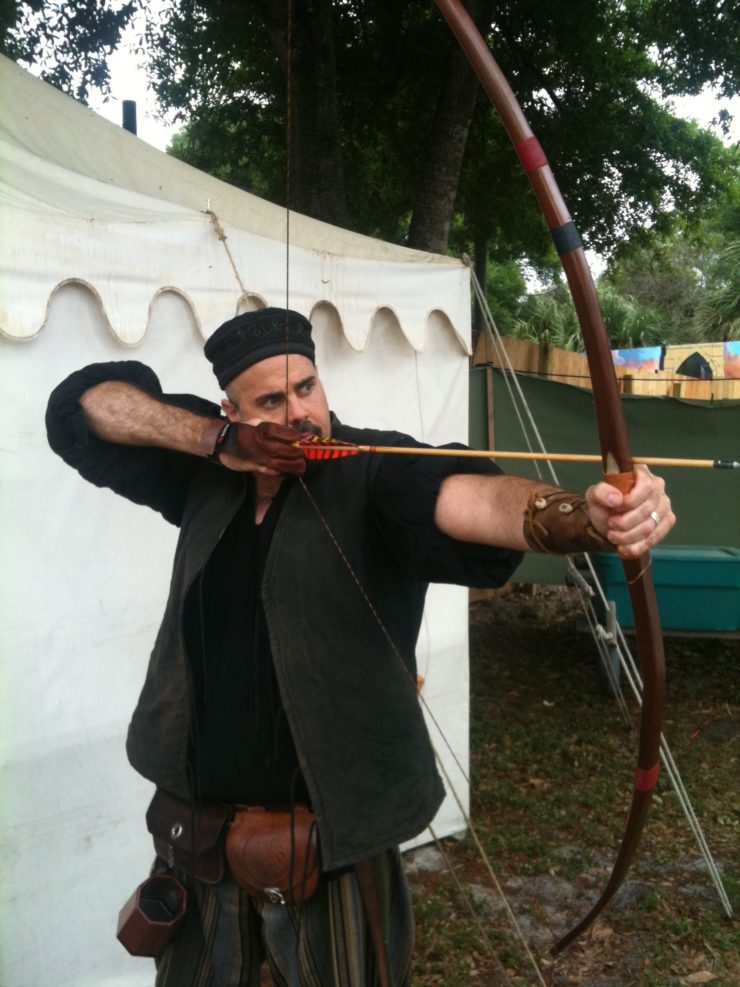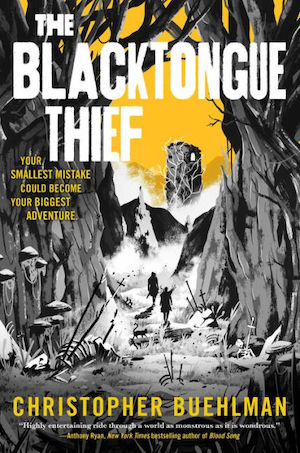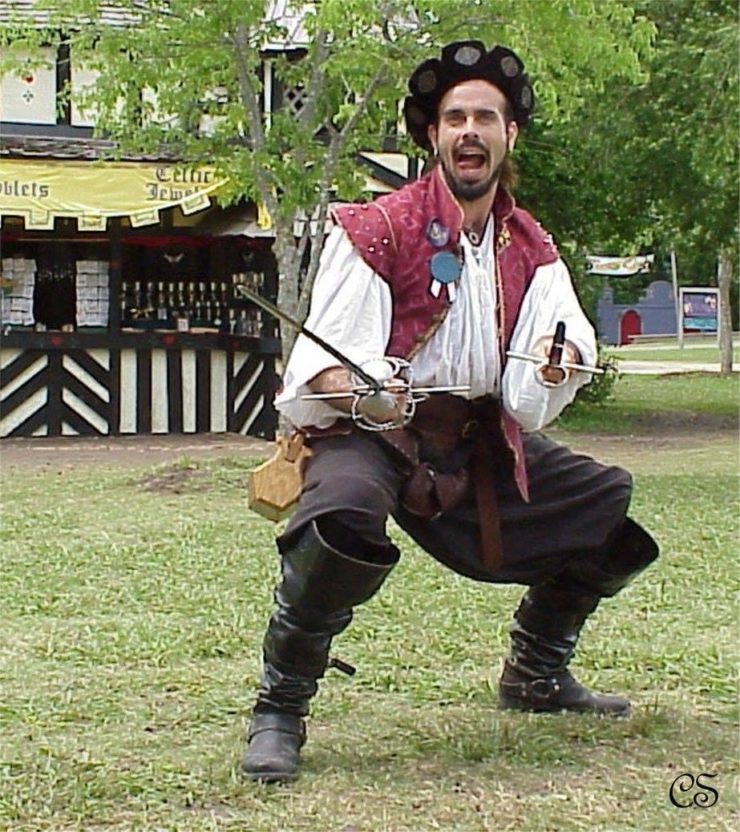In the Spring of 1994, at the age of 25, I was hired to play Tybalt in a production of Romeo and Juliet at the Sterling Renaissance Festival, which would take place in July. Rehearsals would start at the top of June. In May, I got a phone call from Tim Giebel, the fight choreographer, who would also be playing Mercutio. This is not verbatim, but it went about like this:
“How tall are you?”
“Six three.”
“Weight?”
“195.”
“What hand are you?”
“Right.”
“Thank you.”
I didn’t know it at the time, but I had just had my first encounter with a member of the Society of American Fight Directors, or SAFD. That June, I would be challenged to move my body in strange and wonderful ways in order to seem to murder my new teacher with a rapier.
I flashed my blade in moulinets (little windmills), I bound his sword in glissades (gliding attacks), and, when Romeo sufficiently distracted him, I lunged offline like the bastard I was to deliver a punto reverso to my good friend’s kidney. Tim wrote that fight before he arrived and began teaching it to me on day one. Thanks to Tim, I learned pronation from supination (knuckles or thumb to God), my sword’s foible (the stabby, cutty bit) from its forte (the bit toward the hand you block with ), and that lovely encryption known as fight notation––it was a long time ago, but I think it looked something like “T. lunge, M. parry 3, T. cut r hip, M. parry 2”
In 1996, during a blizzardy winter in Cincinnati in which I was briefly snowed in with an instructor, I workshopped and then tested with the society, getting certified as an actor/combatant. For the next decade or so, I would miss no opportunity to include a choreographed fight in a Renaissance Festival or Medieval Faire performance.
Knowing my way around a longsword (as well as being a decent improvisational actor) got me cast as, variously, King Edward I “Longshanks,” King Henry II, The Dauphin of France and, finally, hapless King Aethelred the Unready at the Sarasota Ringling Medieval Faire in its late 1990s heyday. My good friend Pat Johnson and I choreographed fights for the Human Chess Match, in which we dragged, threw, pummeled and wrenched each other for four glorious days in Florida’s mild late winter. We hefted longswords, broadswords, daggers, and maybe an axe (?) in King versus King grand finales for crowds of thousands there between the museum’s statue of David and the blue, blue Gulf of Mexico. I would never be as tough as Pat (inventor of the “Pat Vault”), or as agile as martial artist Derek Conley (the dude should have been in Hollywood. No, really.), but I wasn’t a complete goober, and I could deliver a line. This was some of the biggest fun I ever had.
Of course, people who enjoy choreographing sword and dagger fights will sometimes want to spar with these toys, so that happened. A lot. Whether suited up and armed with blunt metal, or using wooden swords and padded gloves, I beat the shit out of my friends and was beaten in return in renfaire parking lots and during-the-week food courts from New York to Texas.
Somewhere along the way I met the supremely talented Bill Darr of Whipperwill Archery, and acquired another historical habit—primitive archery. I bought an 82 pound orange osage longbow, and proceeded to thump targets with it, poorly at first, and never expertly, but eventually with some consistency. The weight was excessive for target shooting, as Bill wisely warned, and my addiction would cost me shoulder grief later in life, but if launching arrows with that beast was wrong, I didn’t want to be right.

So here I am, in my early fifties, no longer in quite the same physical shape I once maintained, a bit sore about those joints I abused for fun and profit. But those days swinging steel and bending wood? They were delightful. And I believe they now serve me well as a fantasy and historical horror author. I believe experience grounds the action scenes and makes them more plausible.
Joe Abercrombie is a favorite author of mine, and no small part of that is because of the naturalistic (and brutal) way he writes violence—and, importantly, its costs and aftermath. In The Blade Itself, a talented young fencer finds himself in his first real fight, and does alright—until bludgeoned in the face by an adversary who got on his blind side. He spends much of the remaining journey moaning in a cart, on a liquid diet. In good fiction, there’s a difference between the fencing ring and the field. Mr. Abercrombie knows how to write both scenarios. Consider this for-keeps rapier fight, from Best Served Cold, in which Monza Murcatto struggles to avenge her brother’s murder by General Ganmark, a far superior swordsman.
He slashed at her, but instead of backing off she came in close, caught his sword, their hilts scraping. She tried to trip him, but he stepped around her boot, just kept his balance. She kicked at him, caught his knee, his leg buckled for the briefest moment. She cut viciously, but Ganmark had already slid away and she only hacked a chunk from some topiary, little green leaves fluttering.
You can see it, right? As clearly as if the great William Hobbs had choreographed two actors in one of his brilliant film duels. If Mr. Abercrombie hasn’t got significant experience fencing or stage fighting, I’ll eat fish for fifty Fridays.
You learn things in a different way by doing them than by reading about them. Holding a longsword in a guard for a long time fatigues your shoulders. It can be hard to tell where a blow is going to land, a talent that grows with practice; sometimes we’re struck not because we’re too slow, but because we misjudge trajectory or reach and end up in the wrong place. Sparring with rapiers, it’s easy to get whacked in the back, not because, as Vlad Tepes would have assumed, you turned to run, but because you came in low while your opponent slashed down.
Writing scenes of medieval or fantasy combat triggers strong sense memories for me, making it easier to choreograph the action for my characters, or communicate what they’re feeling in the moment. I could perhaps have written the scenes below without practical experience, but not in the same way:
He now rushed at the Comte d’Évreux, who, blinded by sweat and confused by his opponent’s motion, parried high, protecting his head, using his mailed palm to reinforce the blade near the point. He was right that the stroke would be heavy. He was wrong about where it would land. Thomas caught him squarely in the breastplate, his hips sunk into the blow; but the armor was Milanese, and, though it dimpled with a loud clang under the war axe, saved the outmatched Comte’s life again. He fell backward onto his ass…Chrétien, Comte d’Évreux, dug in with his heels to swivel on that ass, keeping his sword high to parry. The sword seemed to weigh as much as a small tree. The bearded cuckold had put the sun behind him and was about to kill him. With a whoring axe, as if he were a whoring capon. He tried to remember a prayer but couldn’t think of one. (Between Two Fires, 2012)
I pulled and loosed first, feeling the good release of pressure in my fingers and the bite of the bowstring on my inner arm. I also had that warm-heart feeling when you know you’ve shot true—if you haven’t handled a bow, I can’t explain it. I heard the hiss of my fellows’ arrows chasing mine. But the target was already moving—she crouched and turned so fast she seemed to disappear behind the shield. Never mind that it wasn’t a large shield—she made herself small behind it.
(The Blacktongue Thief, 2021)
They say write what you know. That’s good advice that dovetails nicely with “Do what you love.” I loved, and still love, period arms and armor, and, if I cannot now in good conscience charge anybody money to watch me wield them, I can at least try to write about them in a way that persuades and entertains.
Buy the Book


The Blacktongue Thief
Christopher Buehlman is the winner of the 2007 Bridport Prize for Poetry and the author of several plays and five novels: The Suicide Motor Club, The Lesser Dead (named the American Library Association’s Best Horror Novel of the Year), The Necromancer’s House, Between Two Fires, and Those Across the River (a World Fantasy Award nominee for best novel).










